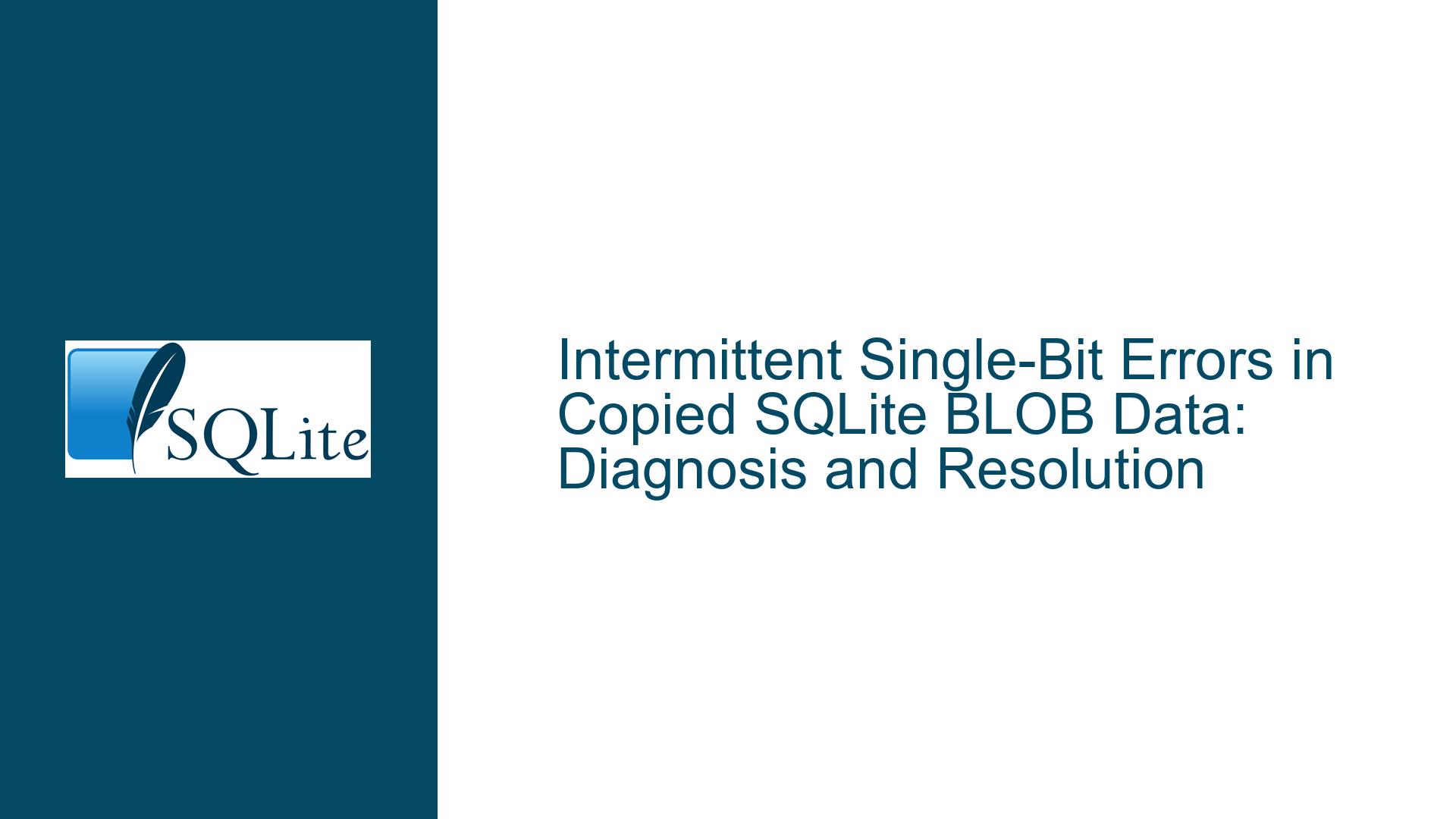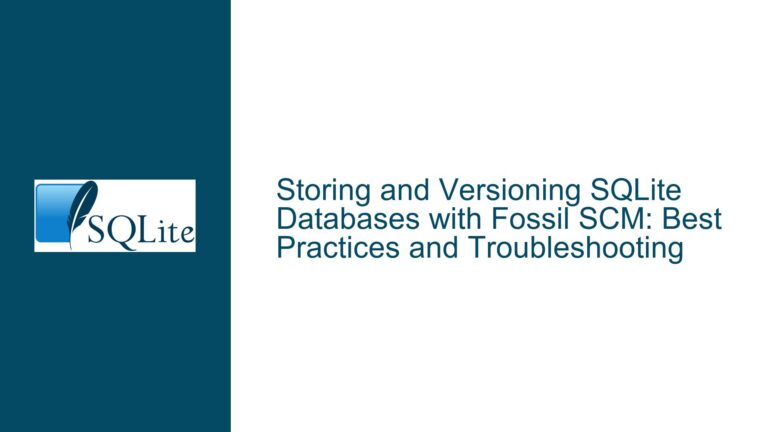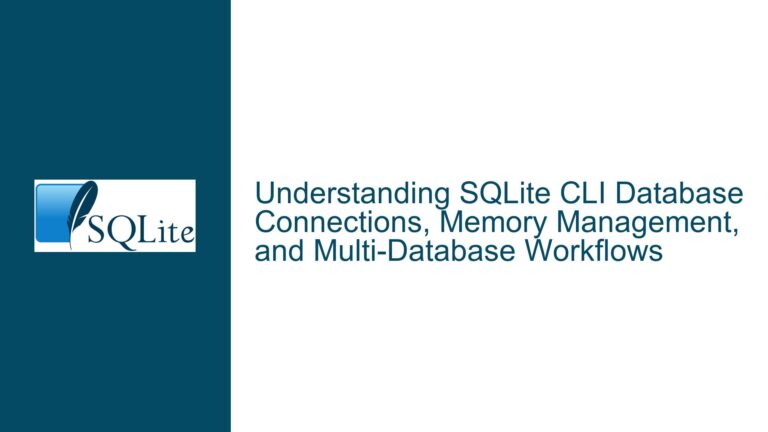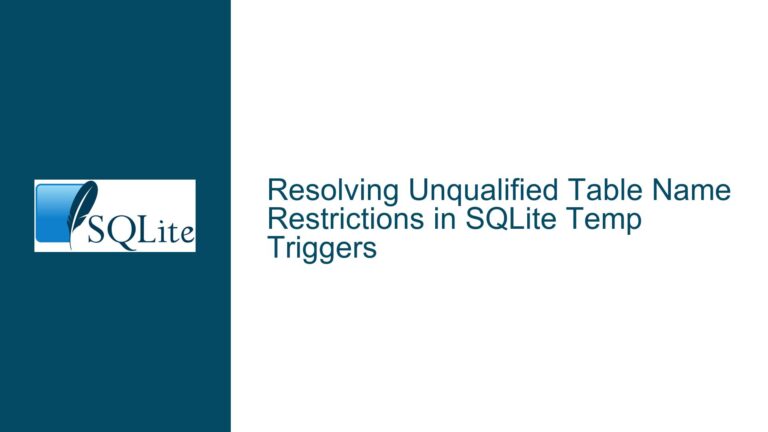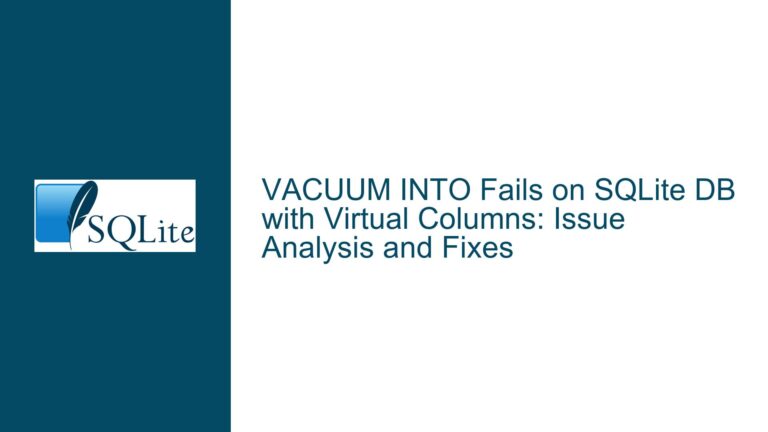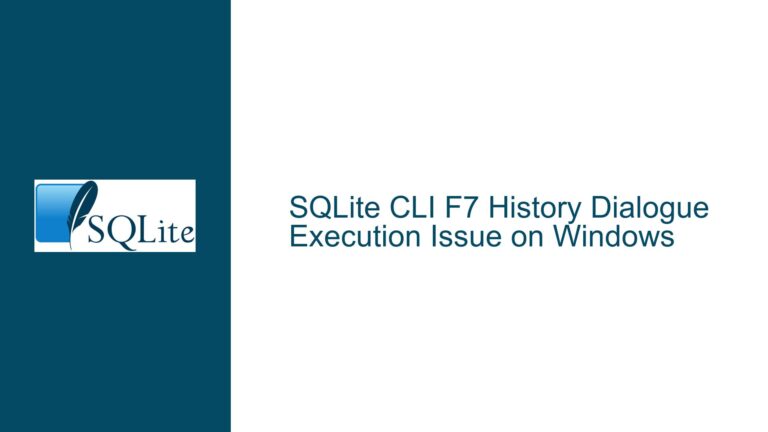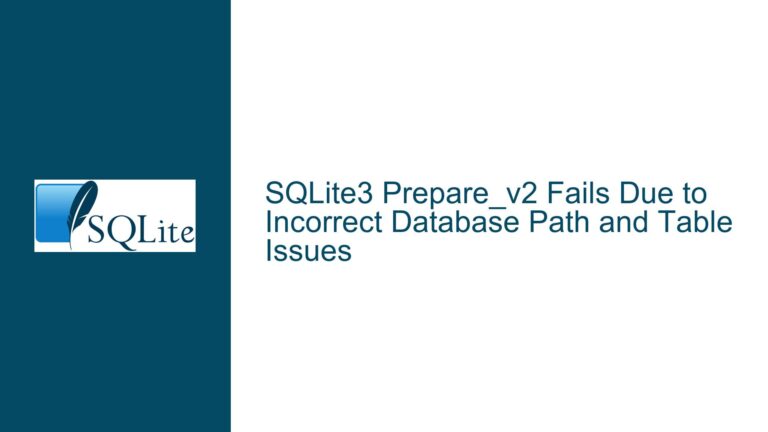Intermittent Single-Bit Errors in Copied SQLite BLOB Data: Diagnosis and Resolution
Issue Overview: Rare Single-Bit Mismatch Between Source and Copied BLOB Data
This issue involves an application that reads large BLOBs (10 MB each) from an SQLite database in a read-only, multithreaded environment. The workflow includes preparing statements, stepping through results, retrieving BLOB data via sqlite3_column_blob, copying the data to newly allocated memory, and comparing the original and copied data with memcmp. The problem manifests as a rare mismatch (approximately once per 100 GB of processed data) where the source and destination buffers differ by exactly one bit in the middle of the data. The environment uses SQLite’s latest version on 64-bit Windows, with no concurrent writes and per-thread prepared statements.
Key characteristics of the problem:
- Non-deterministic occurrence: Errors are sporadic and infrequent, making reproduction difficult.
- Single-bit errors: The discrepancy is localized to one bit in the middle of the 10 MB BLOB.
- Multithreaded context: Threads operate independently with dedicated resources (statements, memory allocations).
- No database modifications: All operations are read-only.
The challenge lies in identifying the root cause of the single-bit corruption given the apparent correctness of the code and the absence of shared mutable state between threads.
Possible Causes: Memory Corruption, Concurrency Edge Cases, and Hardware Faults
1. SQLite BLOB Pointer Lifetime and Memory Reuse
SQLite’s sqlite3_column_blob returns a pointer to an internal buffer that may be invalidated by subsequent SQLite API calls. Specifically:
- The pointer is valid until the next call to
sqlite3_step,sqlite3_reset, orsqlite3_finalize. - If the application reads the BLOB data after one of these calls, it may access invalid memory, leading to undefined behavior.
In this scenario, the code copies the BLOB immediately after retrieval, which should comply with SQLite’s lifetime rules. However, if the application inadvertently triggers a reentrant SQLite operation (e.g., logging callbacks or memory allocation hooks) before copying the data, the buffer could be overwritten.
2. Thread Synchronization and Shared Cache Contention
While the application uses separate statements per thread, SQLite’s default threading mode allows concurrent reads but requires careful management of database connections. If threads share a database connection (even unintentionally), internal SQLite structures like the page cache or schema could become contention points. For example:
- A thread might reset a statement while another thread is still processing results.
- Memory-mapped I/O or shared cache configurations could expose subtle race conditions.
3. Memory Allocation Errors in Custom Code
The application’s AllocMem function (presumably a custom allocator) may have latent bugs:
- Heap corruption: Overwriting buffer boundaries in unrelated code paths.
- Thread safety: If
AllocMemis not thread-safe, concurrent allocations could corrupt metadata. - Alignment issues: Misaligned memory accesses on certain platforms (e.g., SSE/AVX requirements).
4. Undetected Hardware Faults
Hardware-related causes include:
- Faulty RAM: A single bad memory cell could flip a bit during read/write operations.
- CPU cache inconsistencies: Write-back caching errors in multi-socket systems.
- Storage layer corruption: Silent data corruption on disk or in the OS page cache.
5. Compiler or Library Optimization Artifacts
Aggressive compiler optimizations (e.g., auto-vectorized memmove or memcmp) might introduce rare edge cases, especially with unaligned memory operations. Similarly, linking against different runtime library versions could alter memory management semantics.
Troubleshooting Steps, Solutions & Fixes: Systematic Isolation of Failure Modes
Step 1: Validate BLOB Pointer Lifetime and SQLite API Usage
- Instrument SQLite API calls: Log the sequence of
sqlite3_step,sqlite3_column_blob, andsqlite3_finalizecalls across threads. Verify that no intervening API calls occur between retrieving the BLOB pointer and copying the data. - Test with SQLite’s debug APIs: Use
sqlite3_db_statuswithSQLITE_DBSTATUS_LOOKASIDE_USEDto monitor internal memory usage patterns. Sudden changes might indicate unintended buffer reuse. - Disable memory-mapped I/O: Set
PRAGMA mmap_size=0to ensure BLOB data is read directly from heap memory instead of memory-mapped files, which have different lifetime guarantees.
Step 2: Stress-Test Memory Allocation and Threading Logic
- Replace
AllocMemwith system allocator: Usemalloc/memcpy/freeto eliminate custom allocator bugs. If the issue disappears, auditAllocMemfor thread safety and alignment guarantees. - Enable address sanitizers: Compile the application with tools like Clang’s AddressSanitizer (ASan) or Microsoft’s Application Verifier to detect heap corruption.
- Force single-threaded execution: Temporarily restrict the application to one thread. If the error vanishes, focus on thread synchronization or shared resource issues.
Step 3: Rule Out Hardware and Low-Level Storage Issues
- Run memory diagnostics: Use tools like Windows Memory Diagnostic, MemTest86, or
memtesteron Linux to identify faulty RAM modules. - Compare on-disk BLOBs with application copies: Compute checksums (e.g., SHA-256) of the original BLOBs stored in the database and compare them with the copied buffers. If discrepancies exist only in memory, hardware faults are likely.
- Test on alternate hardware: Execute the same workload on a different machine to isolate environmental factors.
Step 4: Audit SQLite Configuration and Compilation Flags
- Recompile SQLite with debugging symbols: Use
-DSQLITE_DEBUGto enable internal consistency checks, such as verifying heap integrity after each API call. - Enable crash-proof modes: Configure
PRAGMA journal_mode=WALandPRAGMA synchronous=FULLto ensure robust transaction handling, even though the database is read-only. - Disable compiler optimizations: Build the application and SQLite with
-O0to rule out optimization-induced bugs.
Step 5: Implement Redundant Data Integrity Checks
- Add pre-copy validation: Compute a checksum of the
sourcebuffer immediately aftersqlite3_column_bloband log it. Compare this with a post-copy checksum ofdest. If mismatches occur beforememmove, the corruption originates from SQLite or earlier steps. - Use ECC memory: Upgrade to Error-Correcting Code (ECC) RAM to detect and correct single-bit errors automatically.
- Leverage SQLite’s incremental BLOB I/O: Use
sqlite3_blob_opento read BLOBs incrementally, reducing the window for memory corruption.
Final Resolution and Preventative Measures
In the original discussion, the root cause was traced to faulty RAM. To prevent recurrence:
- Deploy hardware monitoring: Use tools like
smartmontoolsfor storage health checks and IPMI for RAM error tracking. - Adopt checksumming layers: Integrate CRC32 or hardware-assisted integrity checks (e.g., Intel SGX) for critical data paths.
- Implement fault injection testing: Artificially induce single-bit errors during testing to validate error-handling logic.
By methodically isolating components—SQLite API usage, memory management, threading, and hardware—the intermittent single-bit errors can be diagnosed and mitigated with precision.
